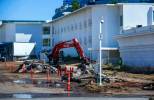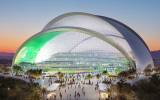In stadium pursuit, 51s learn from those before them
CHARLOTTE, N.C.
When Dan Rajkowski joined the Charlotte Knights in 2005, work was already underway to secure a new stadium. Talks had been on and off since the late 1990s.
And yet, Rajkowski — now the team’s executive vice president and COO — and the Knights faced a “litany of things” as they tried to get BB&T Ballpark built.
The ballpark, which finally opened in 2014, was financed through a private-public partnership and cost $54 million. It is one of the newest and, by all accounts, nicest in Triple-A baseball.
Wednesday, it was on full display as the Knights hosted the Triple-A All-Star Game, providing both a stark contrast from Cashman Field, which opened in 1983, and some tips for the 51s as they continue their push for a new stadium, which they hope will open in 2018.
Like in Charlotte, the 51s hope to use a private-public partnership for a new park which would cost around $60 million. As they prepare for a new stadium of their own, they’ve looked to teams with recently built stadiums, like Charlotte and El Paso, for advice.
Problems with Cashman Field — from sewage overflow to a lack of outdoor batting cages and beyond — have been widely documented, though Pacific Coast League President Branch Rickey said he thought the issue was less about Cashman itself as it is about what other stadiums have to offer.
“You can’t compare the stadiums of yore, the stadiums of olden days to the stadiums of today put in the right spot,” Rickey said as he looked around a club level packed with fans, young and old, taking in the All-Star Game. “You can’t compare them. It’s apples and oranges and there are people in Las Vegas that don’t have this 72 dates a year.”
“This,” is a state-of-the-art facility that has helped moved the Knights from being one of the worst-drawing teams in the league when they were in Fort Mill, South Carolina, to one of the best. The Knights averaged 3,803 fans per game in 2013. The next season, that number jumped to 9,686 when BB&T Ballpark opened.
Nestled in the middle of Charlotte with city buildings shooting up beyond the outfield, 51s third baseman T.J. Rivera called the park the nicest he’s played in throughout his minor league career, saying the backdrop felt like something a big league stadium would have.
Teammate Travis Taijeron expressed similar sentiments. A native of San Diego, Taijeron said BB&T Ballpark reminded him of Petco Park, which just hosted the Major League Baseball All-Star Game on Tuesday.
“It’s a nice environment and it’s a great place to bring your families and all that, from what I’m told,” Taijeron said. “Obviously you could see a lot of families out in the stands. A lot of positivity. … It makes it a lot more fun when you’ve got that kind of environment around you and you’ve got a stadium like this that draws a lot of people.”
That’s exactly what the 51s are hoping to have a couple years down the road. They believe, attendance-wise, they’ll see a similar upshot to Charlotte.
Before the stadium was built, Rajkowski predicted the Knights would draw 600,000 fans per season and he remembers people looking back at him as if he was crazy.
“I had to really battle that but I believed 600 and I admit today I was wrong. We drew 680 and 660 the next year. We should consistently do that,” Rajkowski said. “(Las Vegas has) a lot of similar challenges. Big city, major city, major league sports thinking, but they would jump to the top of the Pacific Coast League in attendance.”
The 51s currently draw 4,979 fans per game, which is 26th overall of 30 Triple-A teams. At 8,957, Charlotte is first overall.
“How would Las Vegas fail to do what we are doing in El Paso and Charlotte and in Sacramento and in Columbus, Ohio?” Rickey said. “Lehigh Valley, Pennsylvania. Just look around Triple-A.”
As they attempt to re-create the success teams like Charlotte and El Paso have had with their new parks, 51s leaders, including president and COO Don Logan, as well as representatives from the Howard Hughes Corporation took a trip to both stadiums last year.
“That’s the beauty of this industry is we’re all friends. There’s only 30 of us. We share information about a number of things,” 51s president and COO Don Logan said. “Obviously this is one of the newer stadiums so (we were) talking to (Rajkowski) about what they went through, what works.”
One of the big things that has led to the success of BB&T Ballpark is the location of the park. After the stadium was built, Rajkowski estimated there were 1,500 apartment units created that were directly associated with the ballpark as the area became even more developed.
The 51s stadium would move the other way — from downtown to the suburbs, with Summerlin as the new park’s location.
“There’s a saying about (how) you have to fish where the fish are,” MILB President and CEO Pat O’Conner said. “You want a place that’s easy to get to, attractive to get to, convenient to get to and in your case in Las Vegas, that’s probably not downtown.”
Logan believes the proposed Summerlin location would have the “nicest compatible uses around the stadium,” in the league as the park would be near restaurants, shopping, movie theaters and the Red Rock Hotel Casino.
And from talking to those who have been through the process before him, like Rajkowski in Charlotte, Logan is confident the 51s know what needs to be built to help bring about a resurgence — whenever that time comes.
“It’ll be built right. There will be shade, the cooling system will work for the summertime, we’ll have suites, we’ll have a club area like this, we’ll have party decks,” Logan said. “This is awesome. It’s got something for everybody. That’s kind of what you want to do. You want to appeal to the whole market, everybody.”
Betsy Helfand can be reached at bhelfand@reviewjournal.com. Follow on Twitter: @BetsyHelfand





























